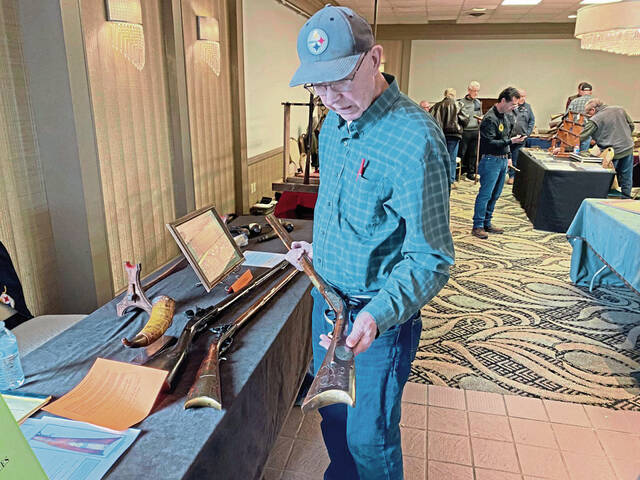Muzzleloader fans revel in bevy of black powder long rifles at collectors show
Tim Claypool admired the handiwork of the craftsmen who made black powder muzzleloader rifles dating to the late 1700s and 1800s and replicas on display at a collectors show Saturday, but he was aiming to see the man who was customizing a long rifle for him.
“I’ve made four guns myself. But he’s a professional and I’m a shoemaker,” said Claypool of Bethel Township, as he walked among the tables of Pennsylvania, Kentucky and Hudson Valley long rifles, as well as powder horns, flints and Indian war clubs.
Claypool was among about 200 people who visited the annual Bushy Run Historic Arms Show. It featured about 40 exhibitors Friday and Saturday at The Lamplighter restaurant along Route 22 in Salem.
Claypool was there to see Mark Wheland of Williamsburg, Blair County, who was making him a .30-caliber black powder flintlock rifle he intends to use for target shooting and squirrel hunting.
Wheland was one of the craftsmen displaying his muzzleloaders along with other gun makers, master carvers and engravers. Exhibitors from West Virginia, Virginia and Ohio were at the show, according to Bill Vance, an organizer of the show that the Old Westmoreland Rifles-Collectors Show Association sponsored.
“We want people to come to those things (gun collector shows) and not be afraid of guns,” said Vance, a member of Old Westmoreland Rifles.
Those at the show showed no such fear. Wheland makes a living out of building the long rifles from parts he purchases — the wooden stock that is stained dark brown, a shiny metal barrel and firing mechanism. With the orders he has, the process can take a few months, he said.
“My goal is to build a gun that blends in with a roomful of originals,” Wheland said. “I want to build something that looks like it belongs with the originals.”
Another exhibitor, Tim Hodges of Winchester, Va., brought four antique rifles, dating to the 1790s to the 1840s, that basically were used for hunting and target practice.
One rifle, whose hand-forged barrel was rifled by hand with a cutting tool in the 1800s, was engraved with a silver eagle, several silver fish and silver half moons.
With all of the silver on the muzzle, Hodges had it valued at $21,000. It may have sold for $25 to $35 in the 1800s, which likely required the owner to be a wealthy man, Hodges said.
A table of unfinished, handheld weapons — Indian war clubs — were displayed by Mike Barton of Ebensburg.
One replica of the menacing clubs used by the native Americans to kill the enemy had an apt name, Braddock’s Field Club.
Barton said that club with a long handle and big rounded head is a duplicate of a club found at the site where a force of native Americans, French and Canadians defeated Gen. Edward Braddock’s force of British soldiers and colonial fighters, at present-day Braddock on July 9, 1755.
Joe Napsha is a TribLive reporter covering Irwin, North Huntingdon and the Norwin School District. He also writes about business issues. He grew up on Neville Island and has worked at the Trib since the early 1980s. He can be reached at jnapsha@triblive.com.
Remove the ads from your TribLIVE reading experience but still support the journalists who create the content with TribLIVE Ad-Free.





